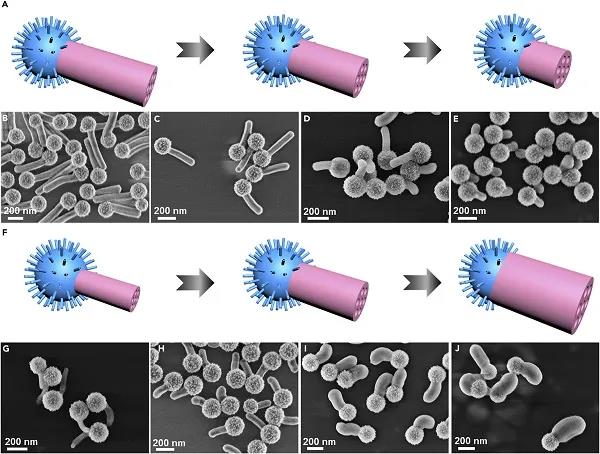
Fudan Chem: "Engine-Trailer" Structure Nano Truck for Enhanced Nano Biological Interactions and Imaging-Mediated Drug Delivery
[Background introduction]
In recent years, nanomaterial-based drug delivery systems have attracted widespread attention in cancer treatment. Studies have shown that compared with small-molecule drugs, nanoparticle-based drug delivery systems can often increase the solubility of drug molecules, reduce the non-specific toxicity of drug molecules, and regulate their pharmacokinetics and biodistribution. However, the future development of nanopharmaceuticals requires the biological properties of nanoparticles to be further improved and enhanced, including good biocompatibility, efficient drug loading, intelligent and controllable drug release; especially enhanced nano-biological interactions, In order to extend the blood circulation time of the nanoparticles, and improve their tumor enrichment and cell uptake performance.
Rough interfaces at the nanoscale show excellent properties in many biological applications, such as biological imaging, bacterial inhibition, and drug delivery. Nanoparticles‘ rough interface greatly affects their adhesion to biomolecules (such as proteins, gene molecules), cellular uptake, and their distribution and metabolism in the body. However, currently reported rough surface nanoparticles generally exhibit relatively low biocompatibility and specific surface area (<200 m2 / g), which limits their further application in nanomedicine. Therefore, nanoparticle-based nanomedicines need to have both a rough interface and a high specific surface area to achieve enhanced nanobiological interactions and efficient drug loading.
[Achievement Profile]
Recently, a team of researchers Li Xiaomin and Academician Zhao Dongyuan of Fudan University developed an "engine-trailer" nano truck for enhanced nano-biological interaction and imaging-guided drug delivery. The authors prepared an asymmetrically structured mesoporous "nano truck" through an interface energy-mediated anisotropic growth strategy. The asymmetric structure of the nano truck uses the rough surface of mesoporous silica (rSiO2) as the "engine-head" to enhance nano-biological interactions; the periodic surface mesoporous silicone (PMO) nanorods with high specific surface area are used as " Trailer-carriage "to improve drug loading performance. By further implanting up-and-down light-emitting nanoparticles in the rough "engine-head", this nano truck not only has enhanced interaction with tumor cells, but also has long-term blood circulation and efficient tumor accumulation, and achieves near-in vivo Controlled delivery of drugs guided by infrared light imaging. Related results "Engine-Trailer-Structured Nanotrucks for Efficient Nano-Bio Interactions and Bioimaging-Guided Drug Delivery" were published in the journal Chem.
[Picture and text guide]
Figure 1.Structure and optical characteristics of nano trucks
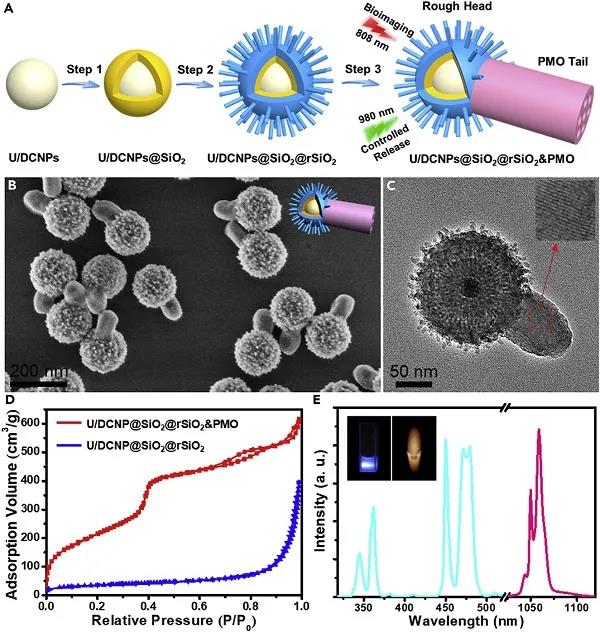
(A) Schematic diagram of the preparation process of nano truck (U / DCNP @ SiO2 @ rSiO2 & PMO);
(B, C) SEM and TEM pictures of nano trucks;
(D) Nitrogen uptake curve of "engine-head" (U / DCNP @ SiO2 @ rSiO2) with core-shell structure and asymmetrical nano truck
(E) Up-conversion and down-conversion luminescence spectra and optical photos of nano trucks excited by near-infrared light at 980 nm and 808 nm.
Figure 2. Controllable synthesis of mesoporous rSiO2 & PMO nano trucks

(A-E) rSiO2 & PMO nano trucks with different PMO lengths obtained by adjusting the initial amount of rSiO2 nanoparticles.
(F-J) rSiO2 & PMO nano trucks with different PMO diameters obtained by adjusting the concentration of BTEE.
Figure 3. Isotropic and anisotropic growth of PMO nanorods driven by interface energy
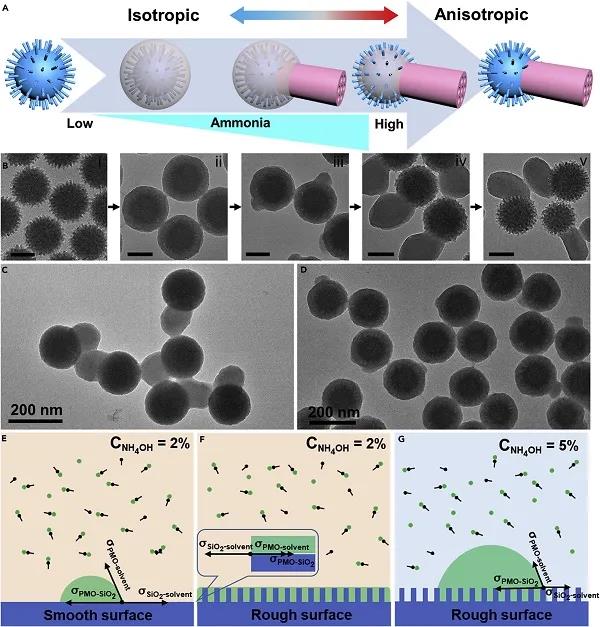
(A) Schematic diagram of the competitive relationship between isotropic growth and anisotropic growth of rough interface PMO affected by ammonia concentration;
(B) rSiO2 nanoparticles (i) and under different ammonia concentrations: (ii) 1v / v%, (iii) 2.25 v / v%, (iv) 3.5 v / v%, and (v) 5v / v%, TEM photo of PMO nanoparticles grown on rSiO2 surface;
(C, D) TEM photo of nanoparticles grown on SiO2 (C) with smooth surface and rSiO2 (D) with rough surface at 2v / v% ammonia water concentration;
(E-G) Schematic diagram of PMO nucleation growth on smooth and rough interfaces.
Figure 4. Isotropic and anisotropic growth of cubic phase structure PMO on rSiO2 surface
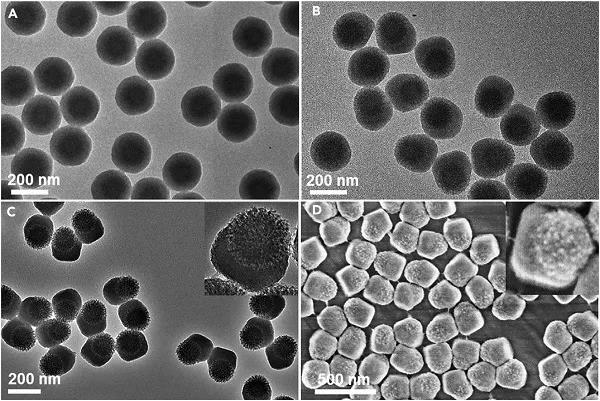
(A ~ C) Under different ammonia water concentrations: (A) 1 v / v%, (B) 3 v / v% and (C) 5 v / v%, PMO with cubic mesoporous structure growing on rSiO2 surface TEM pictures of nanoparticles;
(D) SEM photograph of asymmetric nanoparticles rSiO2 & cPMO obtained at an ammonia concentration of 5 v / v%.
Figure 5. In vitro experiments with nano trucks to enhance drug delivery
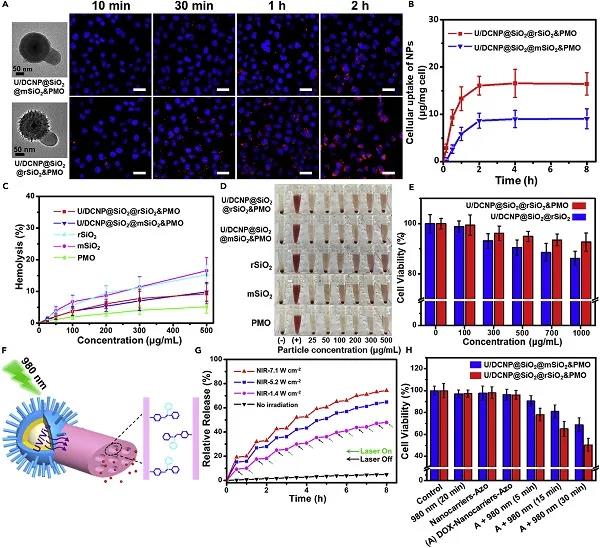
(A) Confocal Laser Scanning Microscopy (CLSM) image of U / DCNP @ SiO2 @ mSiO2 & PMO and U / DCNP @ SiO2 @ rSiO2 & PMO nanocomposite cultured with MCF-7 cells for 10min, 30min, 1h and 2h;
(B) Cell uptake properties of U / DCNP @ SiO2 @ mSiO2 & PMO and U / DCNP @ SiO2 @ rSiO2 & PMO nanocomposites;
(C, D) Hemolysis rate and optical photos of PMO, mSiO2, rSiO2, U / DCNP @ SiO2 @ mSiO2 & PMO and U / DCNP @ SiO2 @ rSiO2 & PMO;
(E) Biocompatibility of "engine-head" U / DCNP @ SiO2 @ rSiO2 with core-shell structure and U / DCNP @ SiO2 @ rSiO2 & PMO nano truck with asymmetric structure;
(F) Schematic diagram of near-infrared light response to controlled drug release;
(G) Drug release curve of nano truck under intermittent irradiation of 980nm near-infrared light;
(H) Survival rate of MCF-7 cells treated under different conditions.
Figure 6.Nano trucks for tumor enrichment and drug delivery under the guidance of bioimaging

(A) NIR-II in vivo imaging of tumor regions in MCF-7 tumor-bearing mice at different time periods after U / DCNP @ SiO2 @ mSiO2 & PMO and U / DCNP @ SiO2 @ rSiO2 & PMO nanocomposites;
(B, C) Quantitative analysis of U / DCNP @ SiO2 @ mSiO2 & PMO and U / DCNP @ SiO2 @ rSiO2 & PMO in tumor (B) and blood (C) at different times.
【summary】
In summary, the authors designed and successfully synthesized an asymmetric structure rSiO2 & PMO nanotruck through the anisotropic growth of PMO nanorods at the rough interface through interface energy-mediated anisotropic growth, and used it to guide drugs for near-infrared light imaging. deliver. The synthetic nano truck has a uniform and adjustable size and structure. The "engine-head" of the nano truck can be further functionalized by embedding U / DCNP for in vivo imaging and near-infrared light-responsive drug controlled release. This work provides a new perspective for designing multifunctional drug delivery systems.
Literature link:
Engine-Trailer-Structured Nanotrucks for Efficient Nano-Bio Interactions and Bioimaging-Guided Drug Delivery (Chem. 2020, 6, 1-16.)
Source: material








